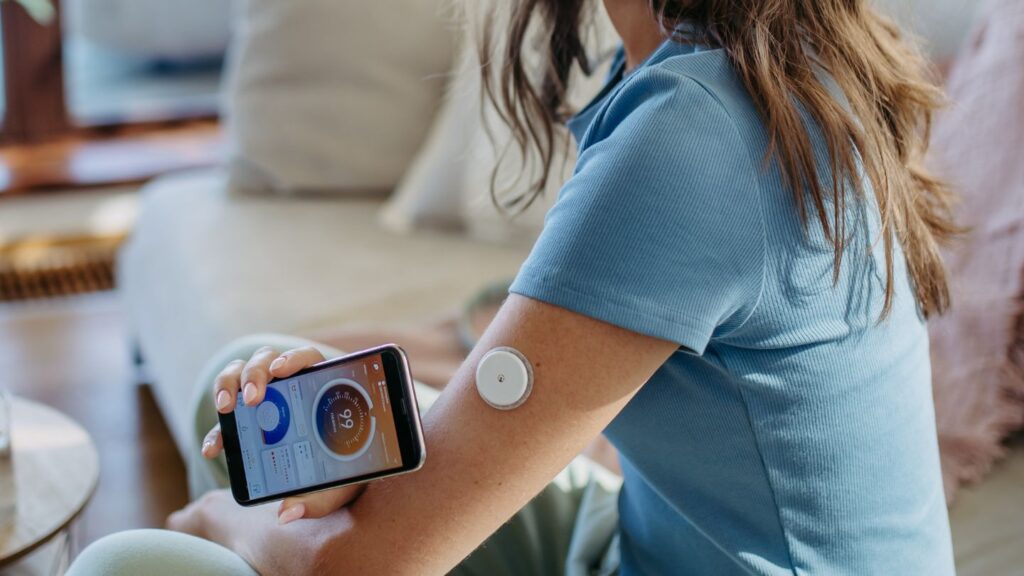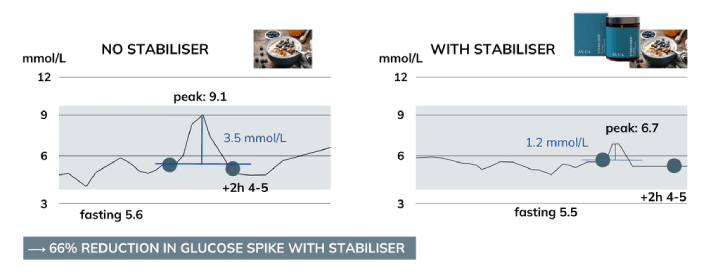
In this article
Free guide to reverse your biological age

- Master the science of rejuvenation.
- Apply proven tips to turn back the clock.
- Transform your health with top longevity specialists.
What is continuous glucose monitoring?
Continuous glucose monitoring simply means estimating your blood glucose levels, using a device, throughout the day and night.
It allows you to check your blood sugar levels at all times, how they change over time, and possibly notice trends based on your lifestyle.
Real-time blood glucose monitoring can be helpful, as trends allow you to check whether your actions align with your health and longevity goals. For instance, the effects of your diet, exercise, stress levels, or supplements can be measured instantly.
Balancing your blood sugar levels is essential to prevent chronic diseases, including diabetes.
What is a CGM?
A Continuous Glucose Monitor (CGM) is essentially a tool that keeps track of your glucose levels continuously. It’s designed to give you a clearer picture of your glucose trends.
The CGM system is made up of three parts:
- Sensor:
This is a small device that’s inserted under the skin, typically on your belly or arm. It’s responsible for measuring the glucose levels in the fluid between your cells, which is a good reflection of your blood glucose levels.
There are two types of sensors – disposable and implantable. Disposable censors sit on the surface under your skin and need to be changed every few weeks. Implantable sensors go deeper and also require changing, but less frequently.
- Transmitter:
This part attaches to the sensor and sends the glucose data wirelessly. It means you don’t need to deal with any cables or direct connections. The transmitter ensures that the glucose data collected by the sensor is sent to a device where you can view it.
- Receiver:
This is where the data ends up. It could be a software on your smartphone, an insulin pump, or a separate device designed specifically to display this information. Here, you can see your glucose levels in real-time, helping you make decisions as you go about your life.
Data shows that everyone responds differently to food. Blood sugar responses can vary greatly from person to person, even while eating the same food.
Use of CGMs with the Avea Stabiliser
Our Stabiliser is formulated with a unique combination of 3 natural ingredients that will help you optimise your health.
This revolutionary formula allows you to regulate your blood-sugar levels by slowing and blocking the absorption of carbs during a meal, minimising glucose peaks and the associated “sugar crashes” that make you feel tired, while still allowing you to enjoy the foods you love.
The Stabiliser also increases insulin sensitivity, concurrently helping you achieve and keep a healthy weight, as well as avoid multiple metabolic diseases that usually become more prevalent as you age.

Our uniqueness also stems from the additional benefits brought in by Berberine and Chromium Picolinate, included in our Stabiliser alongside Reducose®. As a whole, the 3 chosen ingredients work in synergy to safely boost your body into a fat-burning mode, further helping you maintain a healthy blood-sugar level.
For instance, while Berberine will act by lowering your fasting glucose levels, Reducose® will act on your post-meal glucose levels. To top it off, Chromium will assist by considerably increasing your insulin activity. Our stabiliser is the ultimate key to a healthy heart and a healthy weight!

Learn what are glucose spikes harmful.
Who can use a CGM?
Technically, anyone can use a Continuous Glucose Monitor (CGM) to measure their glucose levels, not just people with diabetes.
Whilst CGMs are particularly valuable for those managing diabetes to monitor and adjust their glucose levels closely, they can also offer insights into how different foods, activities, and stress levels affect blood sugar levels in people without diabetes.
If you’re interested in health and wellness, using a CGM can provide real-time feedback on how your body responds to your various lifestyle choices.
Should I consider using a CGM?
Continuous Glucose Monitors (CGMs) are designed to constantly track your glucose levels in real-time, functioning 24/7, regardless of your activities like showering, working out, sleeping, or going about your day.
Many CGMs integrate with mobile applications, offering a variety of useful features, including:
- Tools to log your food and drink intake, monitor your exercise, and keep track of your medication.
- The option to upload your glucose data to a computer or smart device, making it easier to spot and understand your glucose patterns.
- Alerts that notify you when your glucose levels fall too low or spike too high, helping in the prevention of potential health crises.
Some CGM systems allow you to share data with a third party, like a parent, partner, or caregiver. This feature is especially useful for monitoring situations like a child experiencing a significant drop in glucose levels during the night, allowing the CGM to alert a parent in another room.
How to use a CGM?
Continuous Glucose Monitors (CGMs) are handy but need a bit of learning at first. Here’s what you need to get the hang of:
- Putting the sensor on the right spot.
- Sometimes, checking your sugar with a regular test to make sure the CGM is on track.
- Setting up alarms for sugar levels.
- Moving data to your computer or phone to keep an eye on your sugar trends.
- Using what you learn from the CGM to help manage your health better.
Once you get used to these steps, using a CGM becomes a lot easier.
What are the advantages of using a CGM?
Monitoring your blood glucose levels is crucial for several reasons, even if you’re not diabetic.
Here’s why using a Continuous Glucose Monitor (CGM) could be particularly beneficial:
- Personalised diabetes management: Everyone’s body responds differently to food, exercise, stress, and medication. A CGM gives you detailed insights into how your glucose levels react to these factors, allowing you to tailor your diabetes management plan to your specific needs.
- Preventing complications: Keeping your glucose levels within a target range can significantly reduce the risk of long-term complications such as heart disease, kidney damage, and nerve damage. A CGM helps you maintain better control and immediately address any deviations.
- Improving your quality of life: The convenience and reduced need for finger sticks with a CGM can make blood glucose monitoring less intrusive. It provides a sense of security, knowing your actions positively impact your health.
- Empowering decision-making: With real-time feedback and trend data, you can make informed decisions about your diet, physical activity, supplements, and other habits. This empowerment can lead to better glucose control and a more flexible lifestyle.
Continuous Glucose Monitoring in Sports.













